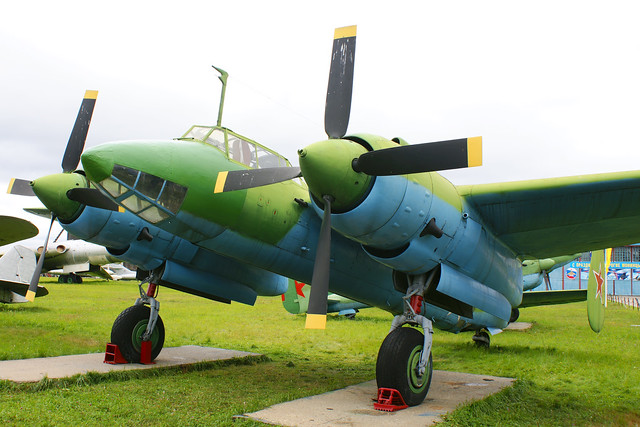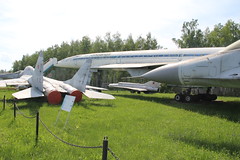Tupolev Tu-144
The Tupolev Tu-144 (Russian: Tyполев Ту-144; NATO reporting name: Charger) is a Soviet supersonic passenger airliner designed by Tupolev in operation from 1968 to 1999.
The Tu-144 was the world's first commercial supersonic transport aircraft with its prototype's maiden flight from Zhukovsky Airport on 31 December 1968, two months before the British-French Concorde. The Tu-144 was a product of the Tupolev Design Bureau, an OKB headed by aeronautics pioneer Aleksey Tupolev, and 16 aircraft were manufactured by the Voronezh Aircraft Production Association in Voronezh. The Tu-144 conducted 102 commercial flights, of which only 55 carried passengers, at an average service altitude of and cruised at a speed of around (Mach 2). The Tu-144 first went supersonic on 5 June 1969, four months before Concorde, and on 26 May 1970 became the world's first commercial transport to exceed Mach 2.
Reliability and developmental issues, together with repercussions of the 1973 Paris Air Show Tu-144 crash and rising fuel prices, restricted the viability of the Tu-144 for regular use. The Tu-144 was introduced into passenger service with Aeroflot between Moscow and Alma-Ata on 1 November 1977, but withdrawn less than seven months later after another Tu-144 crash-landed on 23 May 1978. The Tu-144 remained in commercial service as a cargo aircraft until the cancellation of the Tu-144 program in 1983. The Tu-144 was later used by the Soviet space program to train pilots of the Buran spacecraft, and by NASA for supersonic research until 1999. The Tu-144 made its final flight on 26 June 1999 and surviving aircraft were put on display across the world or into storage.
Development
The Soviet government published the concept of the Tu-144 in an article in the January 1962 issue of the magazine Technology of Air Transport. The air ministry started development of the Tu-144 on 26 July 1963, 10 days after the design was approved by the Council of Ministers. The plan called for five flying prototypes to be built in four years, with the first aircraft to be ready in 1966. The MiG-21I (1968; Izdeliye 21–11; "Analog") I = Imitator ("Simulator") was a testbed for the wing design of the Tu-144.
Despite the similarity in appearance of the Tu-144 to the Anglo-French supersonic aircraft (which earned it the nickname "Concordski"), there were significant differences between two aircraft. The Tu-144 is bigger and faster than the Concorde (M2.15 vs. M2.04). Concorde used an electronic engine control package from Lucas, which Tupolev was not permitted to purchase for the Tu-144 as it could also be used on military aircraft. Concorde's designers used fuel as coolant for the cabin air conditioning and for the hydraulic system (see Concorde for details). Tupolev also used fuel/hydraulic heat exchangers, but used cooling turbines for the cabin air.
The Tu-144 prototype was a full-scale demonstrator aircraft with the very different production aircraft being developed in parallel. While both Concorde and the Tu-144 prototype had ogival delta wings, the Tu-144's wing lacked Concorde's conical camber. Production Tu-144s replaced this wing with a double delta wing including spanwise and chordwise camber. They also added two small retractable surfaces called a moustache canard, with fixed double-slotted leading-edge slats and retractable double-slotted flaps. These were fitted just behind the cockpit and increased lift at low speeds.
Moving the elevons downward in a delta-wing aircraft increases the lift, but also pitches its nose downward. The canards cancel out this nose-downwards moment, thus reducing the landing speed of the production Tu-144s to , still faster than that of Concorde. The NASA study lists final approach speeds during Tu-144LL test flights as . An FAA circular lists Tu-144S approach speed as , as opposed to Concorde's approach speed of , based on the characteristics declared by the manufacturers to Western regulatory bodies. It is open to argument how stable the Tu-144S was at the listed airspeed. In any event, when NASA subcontracted Tupolev bureau in the 1990s to convert one of the remaining Tu-144D to a Tu-144LL standard, the procedure set by Tupolev for landing defined the Tu-144LL "final approach speed... on the order of 360 km/h depending on fuel weight." Brian Calvert, Concorde's technical flight manager and its first commercial pilot in command for several inaugural flights, cites final approach speed of a typical Concorde landing to be . The lower landing speed compared to Tu-144 is due to Concorde's more refined design of the wing profile that provides higher lift at low speeds without degrading supersonic cruise performance – a feature often mentioned in Western publications on Concorde and acknowledged by Tupolev designers as well.
Design
Along with early Tu-134s, the Tu-144 was one of the last commercial aircraft with a braking parachute. The Tu-144 was not fitted with any reverse thrust capabilities, and so the parachute was used as the sole alternative. The prototypes were also the only passenger jets ever fitted with ejection seats, albeit only for the crew and not the passengers.
Engines
SSTs for M2.2 had been designed in the Soviet Union before Tupolev was tasked with developing one. Design studies for the Myasishchev SST had shown that a cruise specific fuel consumption (SFC) of not more than 1.2 kg/kgp hr would be required. The only engine available in time with the required thrust and suitable for testing and perfecting the aircraft was the afterburning Kuznetsov NK-144 turbofan with a cruise SFC of 1.58 kg/kgp hr. Development of an alternative engine to meet the SFC requirement, a non-afterburning turbojet, the Kolesov RD-36-51A, began in 1964. It took a long time for this engine to achieve acceptable SFC and reliability. In the meantime the NK-144 high SFC gave a limited range of about , far less than Concorde. A maximum speed of (Mach 2.29) was reached with the afterburner. Afterburners were added to Concorde to meet its take-off thrust requirement and were not necessary for supersonic cruise; the Tu-144 used maximum afterburner for take-off and minimum for cruise.
The Tu-144S, of which nine were produced, was fitted with the Kuznetsov NK-144A turbofan to address lack of take-off thrust and surge margin. SFC at M2.0 was 1.81 kg/kgp hr. A further improvement, the NK-144V, achieved the required SFC, but too late to influence the decision to use the Kolesov RD-36-51.
The Tu-144D, of which five were produced (plus one uncompleted), was powered by the Kolesov RD-36-51 turbojet with an SFC of 1.22 kg/kgp hr. The range with full payload increased to 5,330 km compared to 6,470 km for Concorde. Plans for an aircraft with a range in excess of range were never implemented.
The engine intakes had variable intake ramps and bypass flaps with positions controlled automatically to suit the engine airflow. They were very long to help prevent surging; twice as long as those on Concorde. Jean Rech (Sud Aviation) states the need for excessive length was based on the misconception that length was required to attenuate intake distortion. The intakes were to be shortened by 10 feet on the projected Tu-144M.
The Kolesov RD-36-51 had an unusual variable con-di nozzle for the nozzle pressure ratios at supersonic speeds. Without an afterburner there was no variable nozzle already available. A translating plug nozzle was used.
Production
Sixteen airworthy Tu-144 airplanes were built:
- the prototype Tu-144, registration number 68001
- a pre-production Tu-144, number 77101
- nine production Tu-144S, numbers 77102 to 77110
- five Tu-144D models, numbers 77111 to 77115.
Although its last commercial passenger flight was in 1978, production of the Tu-144 did not cease until 1983, when construction of the airframe was stopped and left partially complete. The last production aircraft, Tu-144D number 77116, was not completed and was left derelict for many years on Voronezh East airfield. There was at least one ground test airframe for static testing in parallel with the development of prototype 68001.
Operational history
Operational service
The Tu-144S went into service on 26 December 1975, flying mail and freight between Moscow and Alma-Ata in preparation for passenger services, which commenced on 1 November 1977. The type certificate was issued by the USSR Gosaviaregister on 29 October 1977.
The passenger service ran a semi-scheduled service until the first Tu-144D experienced an in-flight failure during a pre-delivery test flight, crash-landing on 23 May 1978 with two crew fatalities. The Tu-144's 55th and last scheduled passenger flight occurred on 1 June 1978.
An Aeroflot freight-only service recommenced using the new production variant Tu-144D ("D" for Dal'nyaya – "long range") aircraft on 23 June 1979, including longer routes from Moscow to Khabarovsk made possible by the more efficient Kolesov RD-36-51 turbojet engines, which also increased the maximum cruising speed to Mach 2.15.
There were only 103 scheduled flights before the Tu-144 was removed from commercial service.
Later use
The Tu-144 programme was cancelled by a Soviet government decree on 1 July 1983 that also provided for future use of the remaining Tu-144 aircraft as airborne laboratories. In 1985, Tu-144D were used to train pilots for the Soviet Buran space shuttle. In 1986–1988 Tu-144D No. 77114, built in 1981, was used for medical and biological research of high-altitude atmosphere radiological conditions. Further research was planned but not completed, due to lack of funding.
Use by NASA
In the early 1990s, a wealthy businesswoman, Judith DePaul, and her company IBP Aerospace negotiated an agreement with Tupolev, NASA, Rockwell and later Boeing. They offered a Tu-144 as a testbed for NASA's High Speed Commercial Research program, which was intended to design a second-generation supersonic jetliner called the High Speed Civil Transport. In 1995, Tu-144D No. 77114 (with only 82.5 hours…
Looking for places related to Tupolev Tu-144?
Those are other destinations to find places related to Tupolev Tu-144:
- Tsaritsyno Park
- Kolomenskoye
- Red Square
- Moscow Kremlin
- Saint Basil's Cathe…
- Danilov Monastery
- Cathedral of Christ…
- Kuskovo
- Domodedovo Internat…
- Tretyakov Gallery
- Ostankino Palace
- VDNKh
- Donskoy Monastery
- State Historical Mu…
- All-Russia Exhibiti…
- Pushkin Museum
- Cosmonauts Alley
- Arbat Street
- Monument to the Con…
- Russian Academy of …
- Bolshoi Theatre
- Worker and Kolkhoz …
- Marfo-Mariinsky Con…
- Moscow Zoo








